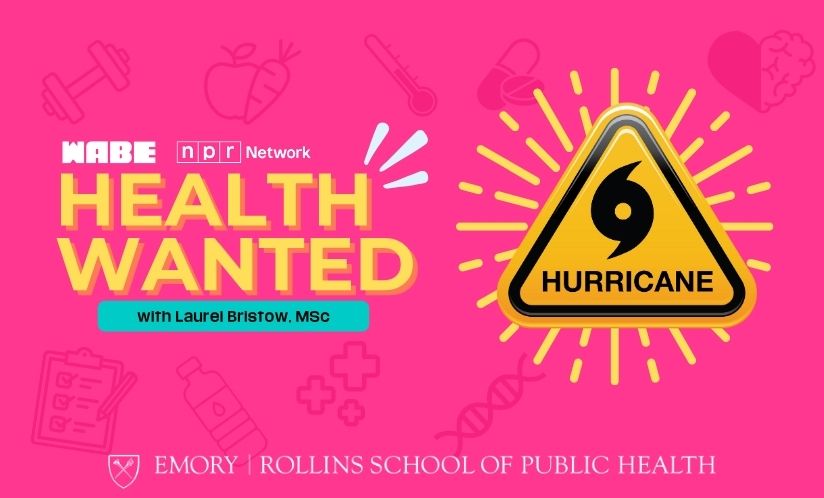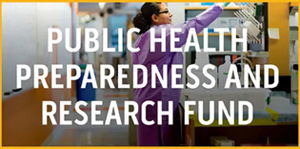Health Wanted: Extreme Summer Weather

HEALTH WANTED, a weekly radio show and podcast produced in partnership with WABE, brings need-to-know public health headlines and breaks down the science behind trending topics.
The Episode
The topic: As summer approaches, the threat of extreme weather begins to rise. This week on Health Wanted, host Laurel Bristow and guest Craig McLean discuss climate, severe weather, and how the National Oceanic and Atmospheric Administration (NOAA) works to keep the public informed and prepared for what’s ahead.
The takeaway: From wildfires to hurricanes, this summer’s weather forecasts point to an increased risk of extreme conditions. Being prepared for these events is essential to stay safe and healthy.
- Typically, long-range forecasts rely on weather patterns like El Niño or La Niña, but this year there are no clear patterns currently in place. Now, predictions are more uncertain, and it can be more difficult to provide advanced warnings for severe storms.
- California will see a higherlikelihood of serious wildfires this summer. If you live near fire-prone areas, you should make sure to have N95 masks to protect yourself from smoke and stock up on non-perishable food and medications. If a fire develops nearby, protect your lungs by paying attention to air quality alerts, and limit indoor air pollution.
- This year’s hurricane season is expected to begin in late May, and predictions are seriously concerning. When preparing for hurricanes, you should be ready with an emergency kit, secure or remove loose outdoor items that could become projectiles, and stock up on clean drinking water.
- Extreme weather is scary, and it is becoming more common. As global temperatures continue to increase each year, storms and severe weather events are becoming more frequent and dangerous. Extreme weather threatens public health today, and will likely continue to do so for future generations.
The Interview
The guest: Craig McLean
The key takeaways:
- NOAA supports the National Weather Service by delivering accurate weather forecasts, especially for extreme events like hurricanes and tornadoes. These forecasts help communities and individuals prepare and protect themselves in advance.
- Beyond forecasting, NOAA also educates local leaders, such as mayors and emergency responders, on how to prepare for severe weather. This outreach helps ensure communities are ready and know how to act during emergencies.
- While the weather service already collaborates with private companies, full privatization could weaken the personal connection between government experts and the public. Government agencies prioritize public welfare over profit, ensuring more reliable information and potentially lower costs for services.
- To further awareness of climate change, consider buying food and products from companies that use environmentally friendly practices or invest in sustainable methods. You can also engage in polite conversations with climate skeptics; informed conversations can influence broader societal attitudes toward climate and weather preparedness.
The Listener Questions
Do indoor waterparks have waterborne diseases?
Whether a waterpark is indoor or outdoor doesn’t really influence its risk of spreading waterborne diseases.
While chlorine kills a lot of pathogens that put people at risk, cryptosporidium is a very resilient parasite that’s fairly tolerant of chlorine and has been the culprit in several waterpark-related outbreaks.
But it can also be found in any water recreation area, like pools, hot tubs, lakes, and rivers.
Splash pads are actually what you should be more concerned about. They’ve become increasingly popular because they don’t have standing water, so the drowning risk is lower, but because they don’t have standing water, sometimes they are exempt from local health regulations that would apply to a water park.
Last year, the CDC released a report on waterborne illness outbreaks from 1997 to 2022 and found that 83% of the outbreaks happened at places that had splash pads and 90% of illnesses were due to cryptosporidium.
So, to keep yourself safe, don’t drink waterpark water, and wash your hands with soap before you have your lunch at the waterpark. You have to ingest cryptosporidium to get sick, but it only takes a little bit.
Make sure not to let your kids go swimming if they’ve had diarrhea in the last two weeks, do check water diapers often to make sure you’re not contaminating the water, and if you see a kid using the splash pad jets as a bidet, stop them.
Does putting a Band-Aid over the belly button prevent motion sickness?
No, they do not. There isn’t even a plausible mechanism for it, either.
Motion sickness happens when the sensation of your body sends conflicting messages to your brain. This can happen if you are sitting still but the fluid in your inner ear is moving, or if your eyes are seeing things move rapidly past you. These signals tell your brain that you are in motion even if you are not.
It is hard to imagine how putting a bandaid on your belly button could change those messages.
If this method works for you, then great. But it’s more likely an example of the placebo effect, like if you tell your kid who gets carsick that this will fix them, and then they think something has been done and they don’t feel sick through sheer will.
Using Band-Aids on your belly button is not something that’s backed by any evidence or even theoretical action.
Catch all the listener questions and Laurel’s answers on the full episode of Health Wanted by:
- Streaming at wabe.org or the WABE app
- Subscribing on Apple or Spotify
- Watching on WABE's YouTube channel


